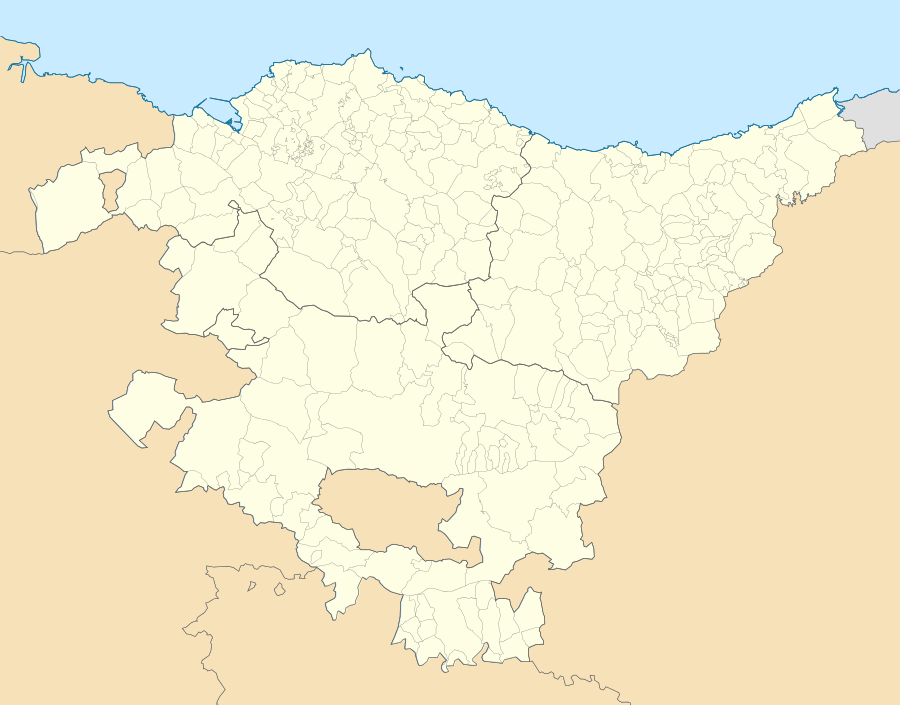Sopela
| Sopela | |||
|---|---|---|---|
| Municipality | |||
|
Saint Peter's church | |||
| |||
 Sopela Location of Sopela within the Basque Country | |||
| Coordinates: 43°22′53″N 2°58′45″W / 43.38139°N 2.97917°WCoordinates: 43°22′53″N 2°58′45″W / 43.38139°N 2.97917°W | |||
| Country | Spain | ||
| Autonomous community | Basque Country | ||
| Province | Biscay | ||
| Comarca | Mungialdea | ||
| Founded | 1841 | ||
| Government | |||
| • Mayor | Gontzal Hermosilla Ramos (EAJ-PNV) | ||
| Area | |||
| • Total | 8.39 km2 (3.24 sq mi) | ||
| Elevation | 62 m (203 ft) | ||
| Population (2014) | |||
| • Total | 13,061 | ||
| • Density | 1,600/km2 (4,000/sq mi) | ||
| Time zone | CET (UTC+1) | ||
| • Summer (DST) | CEST (UTC+2) | ||
| Postal code | 48600 | ||
| Website | Official website | ||
Sopela, also known as Sopelana, is a town and municipality located in the province of Biscay, in the autonomous community of Basque Country, northern Spain. The town is roughly 820 hectares in area, located in the comarca Mungialdea on the north east side of Bilbao and due east of the Nervión river estuary. In the municipality, other former towns like Larrabasterra are now merged to make Sopela larger. The population is 11,185 people, as recorded in the 2003 census. Thriving expansion of the town puts this number to well over 13,000 people. The area of Sopela is situated among green hills and beaches. This makes it a very attractive suburb of Bilbao, with a short commute of 35 minutes on the metro.
History
Since the late 1980s, the population of Sopelana has continued to grow and currently has 13.000 citizens. During the industralization the citizens moved to the urban centres that were more crowded but from that decade on this tendency has reversed. Sopelana has become a residential municipality well communicated with bigger municipalities and with Bilbao. It was at first an eminently turistic destination, where the properties and house owners only moved to spend summer holidays but it has turned into a residential town. At the moment, it is one of the village's with the highest per capita income of the state.
Geographic situation
Sopela belongs to a region called Uribe that is composed by 15 municipalities that are: Arrieta, Bakio, Barrika, Gámiz-Fica, Gatika, Górliz, Laukiniz, Lemoniz, Maruri-Jatabe, Meñaka, Mungia, Plencia, Sopelana and Urduliz. It borders with the Cantabrian sea in the north, what makes Sopelana have spectacular cliffs and beaches (Barinatxe, Arrietara, Atxabiribil and Meñakoz). The municipality of Barrika is located to the Northeast, Getxo to the Northwest, Urduliz to the Southeast and Berango to the Southwest.
Climate
Sopela's oceanic climate is very different from the one of southern Spain. Harsh winds tend to pick up speed along the coast and precipitation is very common all year round. Northern winds often bring the winter temperature to just above the freezing point, but summers are usually comfortable from late May to early September. Snow is common three days each winter on average . The summer climate is warm and the temperatures are moderated by the constant sea breezes.
Beaches
Sopela is known for three beaches Atxabiribil, Barinatxe and Arrietara. They are rather exposed to the elements of the Bay of Biscay and have good conditions for surfers. A fourth beach, Meñakoz is of less appeal for sun worshippers and more for the surfer crowd due to the pebble bed ground. Sopela is frequently the host of regional surf competitions as conditions are adequate for surfing in its beaches. A less famous, but also internationally known event, is the yearly nude race on Barinatxe beach in the fall. Barinatxe is a clothing optional beach. Another special place in Sopela is a small creek called Ikatza known only by its citizens.
Transport
The town is connected to the main transport arteries with two metro stations on the Line 1 of Bilbao Metro and highways.
Larrabasterra station is located to the far south of Sopela in Larrabasterra, while Sopela station (formerly Sopelana) is at the center of the municipality. Several bus routes also connect Sopela to Bilbao and nearby towns, like Barrika, Plentzia, Gorliz and Armintza. These buses are:
- Bizkaibus:
- A3451: Las Arenas - Arminza.
- A3531: Sopelana - Munguía - Gatica.
- A2166: Uribe Kosta - UPV/EHU
There is also a local bus service which connects the town centre with the beaches, it joins the following neighbourhoods: Larrabasterra / Arrietara / Beaches / Sopelmar / Ugeraga / Moreaga / Centre.
Patronal feasts
The patron saint of the town is San Pedro or Saint Peter and his feast days are the most representative ones. They are held at the end of the month of June and they last up to a week and a half. The big day is the 29th. The patroness of the neighbourhood of Larrabasterra is Virgen del Carmen and her feast days are held in mid-July. The big day is the 16th.
Shopping
There are no large shopping areas or malls in Sopela. The shopping centres are located a short car ride away in nearby towns like Getxo, Leioa, Barakaldo or Bilbao. However, the centre of Sopela is full of small shops with a wide variety of goods. Along the main road to West Sopela, there are several youth oriented shops and surf shops open all year round.

External links
| Wikimedia Commons has media related to Sopela. |
- SOPELA in the Bernardo Estornés Lasa - Auñamendi Encyclopedia (Euskomedia Fundazioa) (Spanish)
- Official website (Basque) (English) (Spanish)



